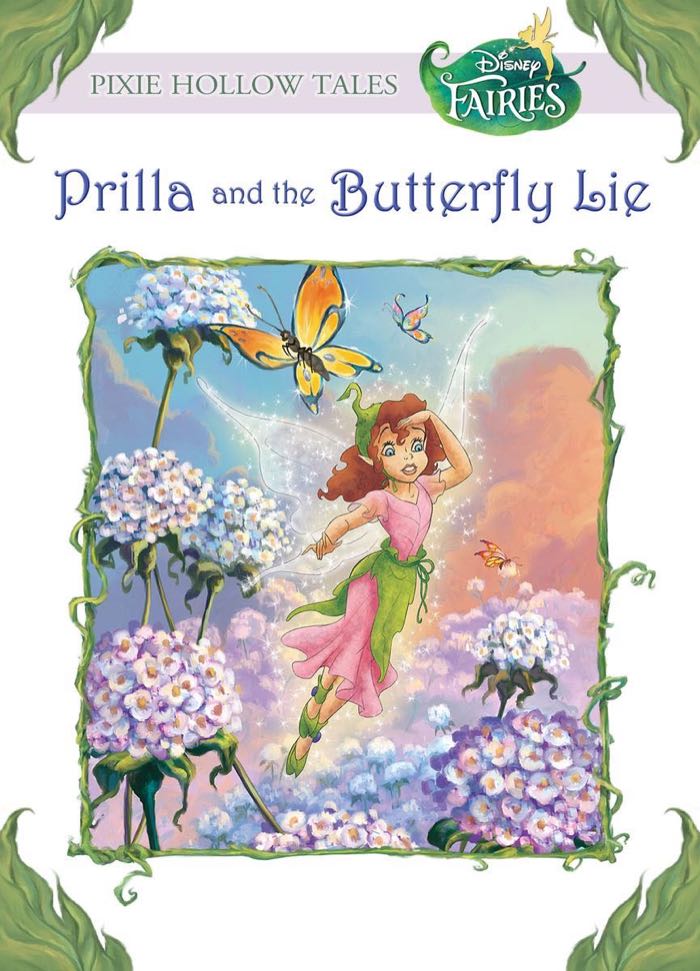Prilla and the Butterfly Lie
Reviewed date: 2009 Jan 14
128 pages
If you thought Tinker Bell was the only Never fairy in Neverland, you may be forgiven. Disney Fairies is a new franchise, barely three years old, cooked up by Disney Consumer Products (DCP) and based on the Tinker Bell character from Peter Pan. The Never fairies live in Pixie Hollow in the heart of Neverland. Their home is the Home Tree. Disney is peddling dolls, toys, books, a magazine, straight-to-DVD movies, and a Disneyworld attraction.
My daughters love the Disney Fairy books, so as a responsible parent I had to read one to judge its content. Prilla and the Butterfly Lie is vapid but harmless. The illustrations are saccharine and oh-so-Disneyesque, but that's hard to avoid when the franchise is Disney Fairies.
Prilla is a fairy with a problem: she's a doormat. Her friend Nettle asks her to help shear caterpillars. Prilla hates caterpillars; she would much rather visit the mainland and appear to children. To avoid hurting Nettle's feelings, Prilla lies and says she can't shear caterpillars because she loves butterflies. The lie gets her out of caterpillar-shearing, but it backfires when all the butterfly-herding fairies get sick and Prilla is drafted. She knows nothing about butterflies. She bungles the job. Her lie is found out, she discovers that she hates butterflies, and she learns a valuable lesson about lying.
The lie is a curious part of the story. Prilla tells Nettle that she can't help with caterpillar shearing because she loves butterflies. Not because she's going to be working with butterflies, but simply because she loves them. It makes no sense. Does the mere fact of liking butterflies disqualify her from shearing caterpillars? The lie Prilla tells to spare Nettle's feelings is no better than telling the truth. It's worse. The truth is Prilla can't shear caterpillars because she has a job to do: visiting children on the mainland. The lie is that Prilla can't shear caterpillars because she loves butterflies and that renders her incapable of tending to caterpillars. As plots holes go, this is a doozy.
The fairy society is curious. Each fairy has a natural talent for something. There are baking-talent fairies, fast-flying-talent fairies, garden-talent fairies, animal-talent fairies, and even caterpillar-shearing-talent fairies. Each fairy works at her own talent, for the good of the community. From each according to her ability, to each according to her need. It's a perfect communist system. It's even better than perfect. Each fairy's place in society is dictated by her magical talent. No fairy will ever be dissatisfied with her lot, because she is happy doing her talent. By the way, this makes the whole premise of Prilla and the Butterfly Lie inconsistent; Nettle would never ask Prilla to shear caterpillars, because Nettle knows that Prilla is a mainland-visiting adventure-talent fairy, and of course she wouldn't want to shear caterpillars.
Perhaps I shouldn't judge a children's book so strictly. My daughters enjoyed the book and didn't complain about the inconsistencies. But just because children don't complain is no excuse for shoddy writing. The books are produced on slick paper with dozens of full-color illustrations; these aren't cheaply-produced. A little attention to the content would not have been out of place.
